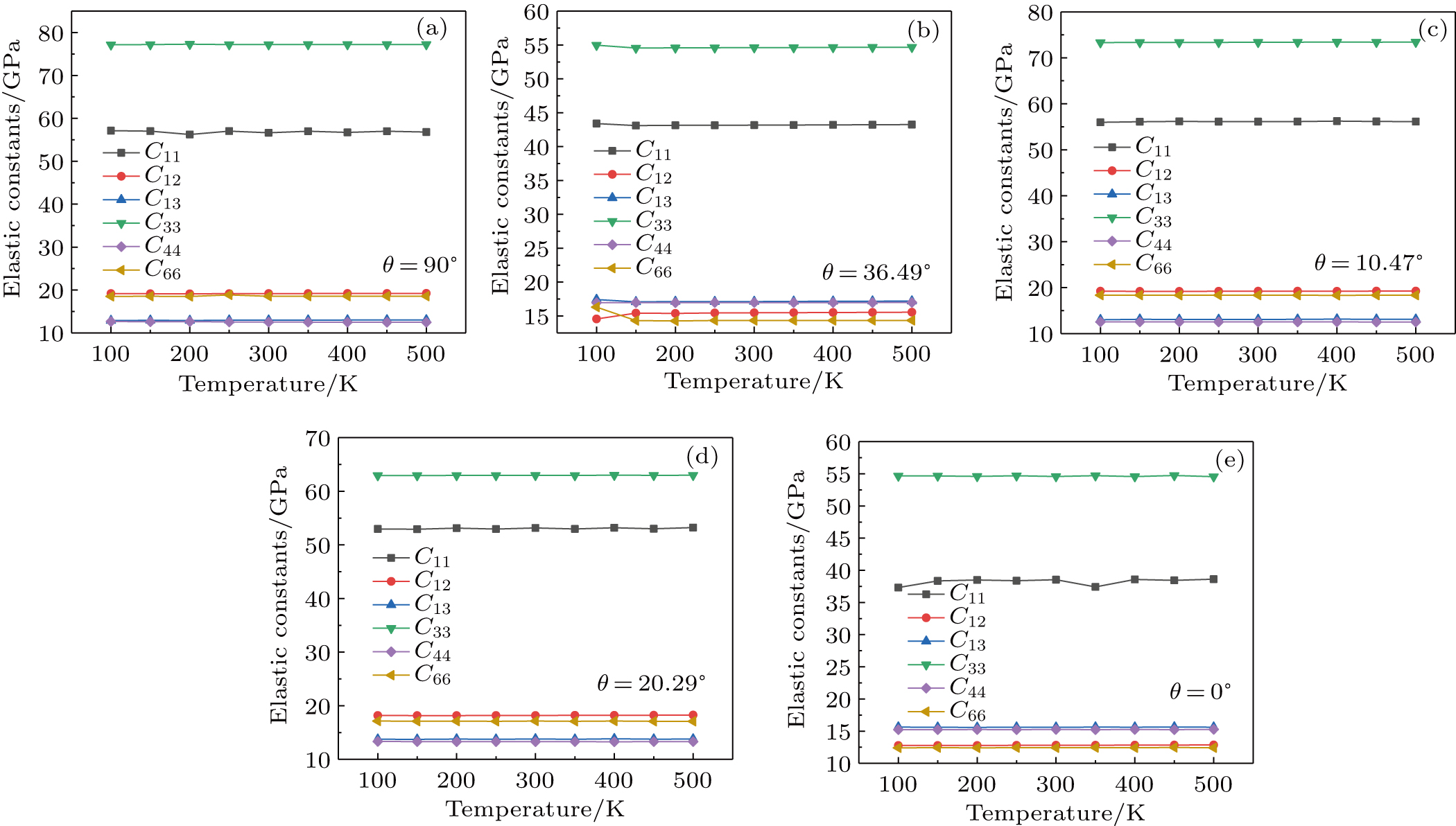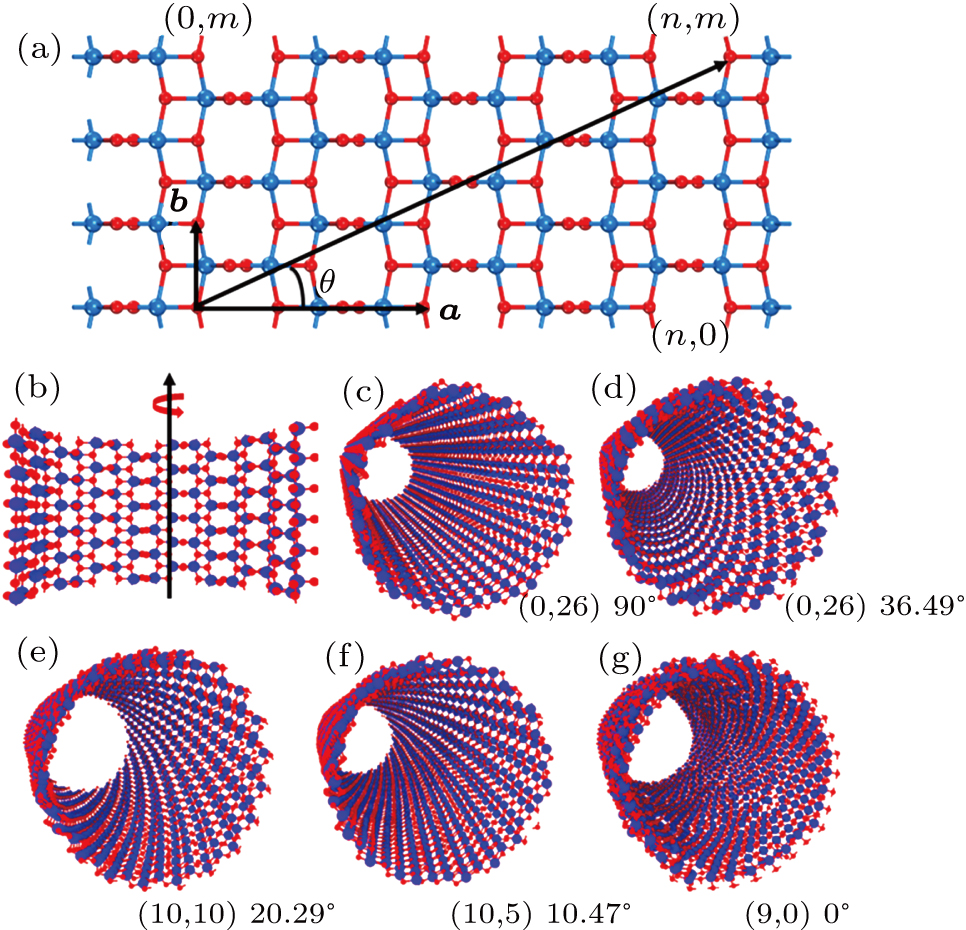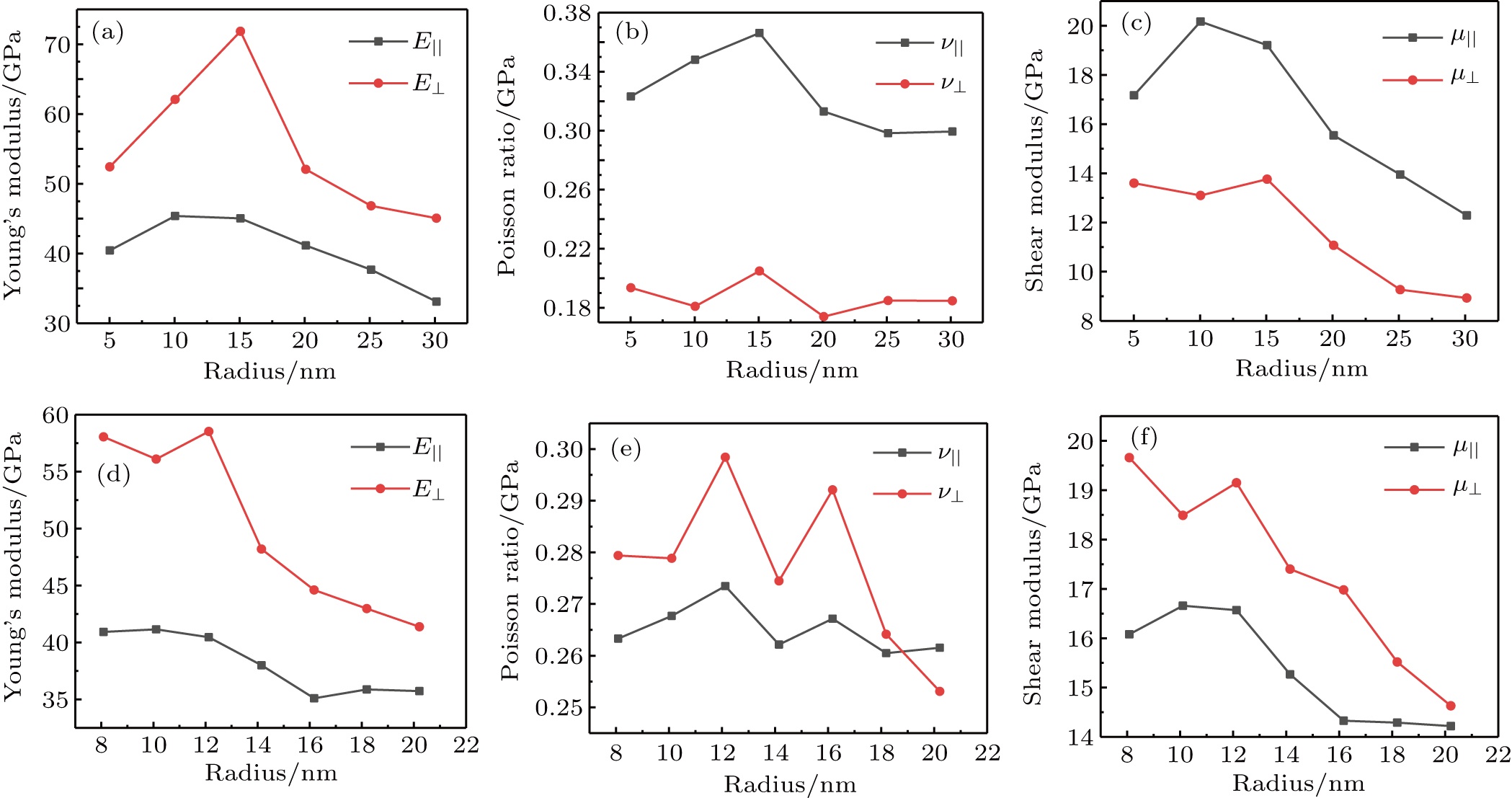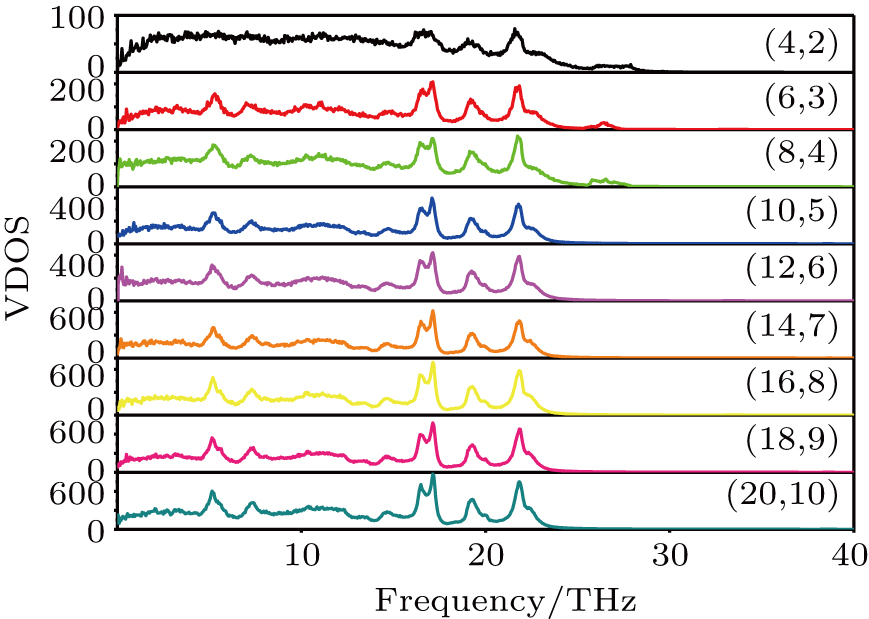† Corresponding author. E-mail:
Project supported by the Key Research and Development Program of Hainan Province, China (Grant No. ZDYF2017098) and the Hainan Provincial Natural Science Foundation, China (Grant No. 519MS025).
The elastic properties of anatase nanotubes are investigated by molecular dynamics (MD) simulations. Youngʼs modulus, Poisson ratio, and shear modulus are calculated by transversely isotropic structure model. The calculated elastic constants of bulk rutile, anatase, and Youngʼs modulus of nanotube are in good agreement with experimental values, respectively, demonstrating that the Matsui and Akaogi (MA) potential function used in the simulation can accurately present the elastic properties of anatase titanium dioxide nanotubes. For single wall anatase titanium dioxide nanotube, the elastic moduli are shown to be sensitive to structural details such as the chirality and radius. For different chirality nanotubes with the same radius, the elastic constants are not proportional to the chiral angle. The elastic properties of the nanotubes with the chiral angle of 0° are worse than those of other chiral nanotubes. For nanotubes with the same chirality but different radii, the elastic constant, Youngʼs modulus, and shear modulus decrease as the radius increases. But there exist maximal values in a radius range of 10 nm–15 nm. Such information can not only provide a deep understanding of the influence of geometrical structure on nanotubes mechanical properties, but also present important guidance to optimize the composite behavior by using nanotubes as the addition.
With the development of science and technology in the past few years, nanostructures have received much attention from many researchers because of their important role in the fields of energy, environment, and production. Among them, titanium dioxide nanotubes (TNTs) have attracted extensive attention. Due to its large specific surface area, high chemical stability, excellent catalytic property, great acid, and alkaline resistance,[1] the TNTs have been widely used in fuel cells,[2,3] photocatalytic systems,[4,5] energy storage devices,[6,7] gas-sensitive sensors,[8] pH sensors,[9] and other fields. The main preparation methods of titanium dioxide nanotubes are the template-assisted,[10,11] hydrothermal,[12–14] sol–gel,[15] and electrochemical anodization methods.[16,17] However, the TNTs structures prepared by different methods are different from each other and thus present different performances. In order to optimize the composite performance by using TNTs as the addition, the investigation into their elastic and other mechanical properties are of great importance. For example, titanium dioxide nanotubes play an important role in mechanically enhancing bone bonding and epoxy resin.[18,19] However, the elastic and mechanical properties of a single titanium dioxide nanotube are hard to obtain experimentally. Thus, there is still much room for studying the elastic and mechanical properties of titanium dioxide nanotubes.
Like carbon nanotubes, titanium dioxide nanotubes are made of transversely isotropic materials, so they are highly symmetrical in elastic properties and sensitive to the helicity and the radius of nanotubes.[20–22] In order to obtain the elastic properties of TNTs effectively, the elastic constants can be calculated by density functional theory or molecular dynamics. The first principles Vienna ab initio simulation package (VASP) has already predicted the elastic constants of bulk anatase and rutile TiO2 at 0 K,[23,24] and the elastic constants of bulk rutile at various temperatures have been measured experimentally.[25–27] But the elastic constants of TNTs have not been measured nor calculated yet.
In this paper, the single-cycle sheet of TiO2 anatase (101) is curled into a single wall nanotube structure along different chiral directions. The elastic constants of the nanotubes are calculated by the Matsui and Akaogi (MA) potential function through using molecular dynamics. In order to verify the calculated results, we first use this potential function to calculate the elastic constants of bulk anatase and rutile, which demonstrate good accuracy. Then, the elastic constants of the titanium dioxide nanotubes with different chiral angles are further calculated, including Youngʼs modulus, shear modulus, and Poisson ratio. Such a prediction of the TNT elastic properties can provide good theoretical guidance for both experimental and practical applications.
The nanotube symmetry and structure are described on the basis of the so-called layer folding.[28] The single-wall anatase TNT named (n, m) with open ends can be obtained by simple rotation of the (101) anatase surface along different crystalline orientations (Figs. 
In Eq. (




Here we use the well-known MD (Molecular Dynamics) software package large-scale atomic/molecular massively parallel simulator (LAMMPS) to perform the calculation.[30] In this calculation, a classical potential function in the form of a pair of potential expressions with clear physical meaning is selected, which is an MA potential function.[31,32] The MA potential function is expressed as

| Table 1.
Key parameters of MA potential function. . |
Bulk anatase, rutile, and TNTs are made of transversely isotropic materials, so they have a high degree of symmetry in their elastic properties. Based on Hookeʼs law for elastic materials and using Voigt notation, the engineering moduli Cij can be calculated from the following formula:














Rutile is relatively stable in nature and the elastic constants of rutile are obtained experimentally. We use the MA potential function to calculate the elastic constants of bulk rutile from room temperature to 1000 K, and a fairly good agreement is found between our computed elastic constants and those from the experiments.[25,26] (See Table
| Table 2.
Elastic constants, Youngʼs moduli, Poisson ratios, and shear moduli (in unit GPa) of anatase (101) nanotubes with different chiral angles at 300 K, and radius of each nanotube of about 15 nm. . |
| Table 3.
Elastic constants, Youngʼs moduli, Poisson ratios, and shear moduli (in unit GPa) of anatase (101) nanotubes with different radii at chiral angle 10.47° and temperature 300 K. . |
| Table 4.
Calculated and experimental results of elastic constants Cij (in unit GPa) for rutile TiO2 from 300 K to 1000 K. . |
However, the experimental values of anatase elastic constants have not been effectively measured. There exists only the bulk modulus for reference.[38] The elastic constants of anatase at 0 K can be accurately calculated by VASP, and the values are 






















Figure
 | Fig. 2. Elastic constants C11, C12, C13, C33, C44, and C66 at temperatures ranging from 100 to 500 K with chiral angles of (a) 90°, (b) 36.49°, (c) 10.47°, (d) 20.29°, (e) 0°, respectively. |
As can be seen from Table
The elastic constants are also sensitive to the radius of the nanotubes. The relationship between the elastic constants and the radius of nanotubes under the same chiral angle is calculated, where the chiral angles are 7.03° (Table
| Table 5.
Elastic constants, Youngʼs moduli, Poisson ratios, and shear moduli (in unit GPa) of anatase (101) nanotubes with different radii at chiral angle 7.03° at 300 K. . |
| Table 6.
Elastic constants, Youngʼs moduli, Poisson ratios, and shear moduli (in unit GPa) of anatase (101) nanotubes with different radii at chiral angle 13.85° at 300 K. . |
| Table 7.
Elastic constants, Youngʼs moduli, Poisson ratio, and shear moduli (in unit GPa) of anatase (101) nanotubes with different radii at chiral angle 36.49° at 300 K. . |
Table
Because Youngʼs modulus is mainly determined by C11 and C33, Youngʼs modulus also presents an increase and then decrease trend as radius increases. From Figs. 



As shown in Fig.
In this work, the elastic constants, Youngʼs modulus, Poisson ratio, and shear modulus of anatase nanotubes were calculated by using MA potential function and transversely isotropic structure model. The elastic constants of TNTs are found to be not significantly affected by temperature. By calculating the elastic constants of nanotubes with the same radius but different chirality, it can be found that the elastic constants are not proportional to the chiral angle. In addition, both C11 and C33 are larger than the other elastic constants due to the transversely isotropic structure. By calculating the elastic constants of nanotubes with the same chirality but different radii, the elastic constants, Youngʼs modulus and shear modulus first increase and then decrease as radius increases. The maximum values appear in a radius range of 10 nm–15 nm, and Poisson ratio fluctuates in a certain range. Nanotubes with a radius range of 5 nm–15 nm have high frequency vibration and large elastic constants compared with big nanotubes. Therefore, the radius of the nanotubes should be as small as possible to enhance their mechanical properties in practice.
| [1] | |
| [2] | |
| [3] | |
| [4] | |
| [5] | |
| [6] | |
| [7] | |
| [8] | |
| [9] | |
| [10] | |
| [11] | |
| [12] | |
| [13] | |
| [14] | |
| [15] | |
| [16] | |
| [17] | |
| [18] | |
| [19] | |
| [20] | |
| [21] | |
| [22] | |
| [23] | |
| [24] | |
| [25] | |
| [26] | |
| [27] | |
| [28] | |
| [29] | |
| [30] | |
| [31] | |
| [32] | |
| [33] | |
| [34] | |
| [35] | |
| [36] | |
| [37] | |
| [38] | |
| [39] | |
| [40] | |
| [41] | |
| [42] | |
| [43] |












































